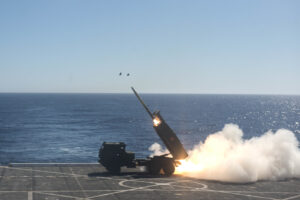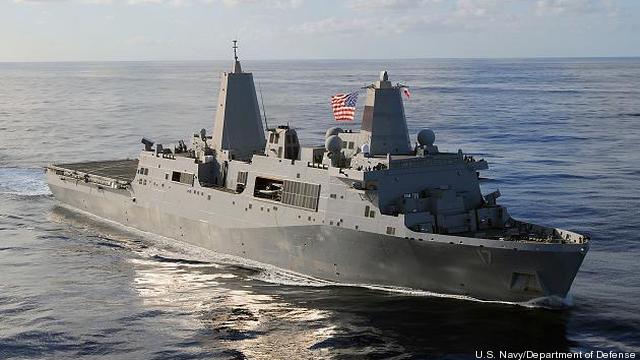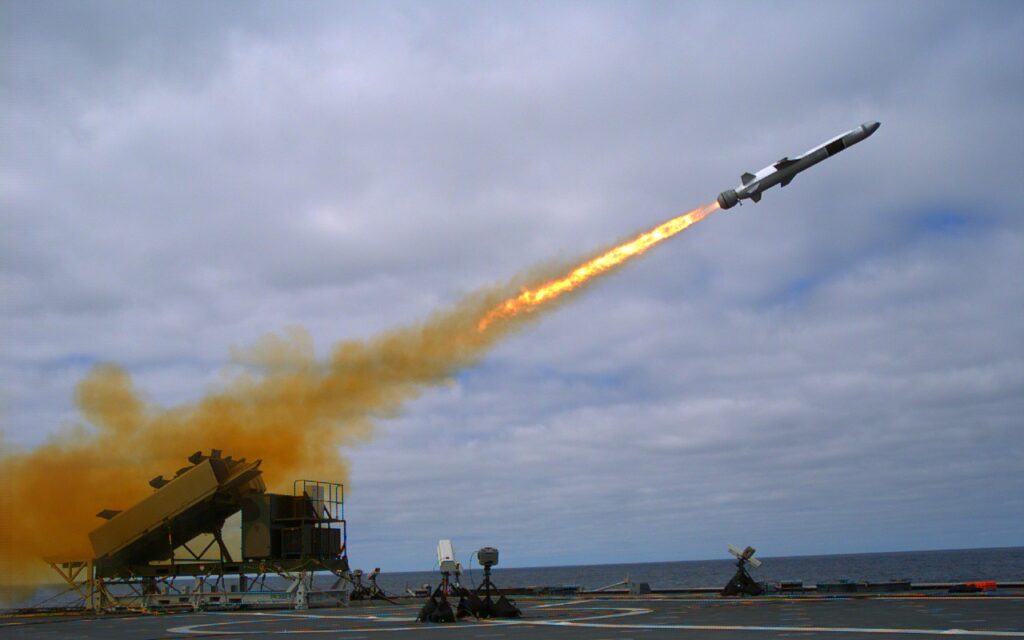Marines, Navy Wrestle With How To Upgun Amphibs
Posted on
ARLINGTON: The Marines want better-armed amphibious warships for high-end combat, but there’s no money in the budget and little room on the ships for their preferred solution, the Vertical Launch System. That leaves them looking at less capable but more affordable upgrades. Those range from bolting small Naval Strike Missile pods onto the deck – as on the Littoral Combat Ship – to parking a HIMARS missile-launcher truck on the back of the ship – as they tested during last year’s Dawn Blitz wargames.

A Marine HIMARS missile launcher fires from the deck of the USS Anchorage during the Dawn Blitz 2017 exercises.
Why does this matter? In a major war against Russia or China, or even Iran, amphibious warships — as currently equipped — would have to rely on escorting destroyers both defensively, to shoot down attacking missiles and airplanes, and offensively, sinking enemy ships and bombarding targets ashore.
But those destroyers might not always be available and, even if they are, they might overwhelmed by the sheer volume of incoming fire. So the Marines want better-armed amphibs that can, ideally, operate unescorted or, at minimum, take on some of the burden of their own defense.
To do that, “the naval force must upgrade the C2 (command and control) suites and introduce Vertical Launch Systems,” Lt. Gen. Brian Beaudreault, the Marines’ three-star deputy commandant for plans, policies, & operations, told the Surface Navy Association conference on Wednesday.
But, I asked him during Q&A, is there actually any money in the budget to add VLS to amphibs? “I’m not aware that there’s funding in the program for VLS,” said Beaudreault, who oversees Marine budgeting. “We can’t afford as a Marine Corps to put it in there.”
Even “more concerning,” Beaudreault added, is “whether the future LPDs can accommodate VLS” at all.
The backstory here: The 11 existing ships of the San Antonio-class LPDs (Landing Platform, Dock) actually have space set belowdecks for the bulky Vertical Launch System tubes, though these were never installed. But the Navy and shipbuilder Huntington-Ingalls Industries are now transitioning to a lower-cost LPD Flight II. (Flight I is replacing aging mid-sized amphibs, Flight II will replace smaller LSD-class vessels, so not as much money was allocated).
Will Flight II LPDs still have room for VLS? Beaudreault wasn’t sure. “I’ll defer to the Navy,” he said.
They won’t, the Navy and the shipbuilder both told me when I asked.
Now, it wouldn’t be too hard to rejigger the design to get that space back if the Navy wanted, said Huntington-Ingalls Industries program manager for LPD, Steven Sloan. In fact, Sloan told me in a phone call, “the Navy could make that decision at any time” – although earlier is easier. Amending the current Request For Proposals so the shipyard can change the blueprints before building anything would be much, much cheaper and quicker than going back and retrofitting a ship once it’s already built.
But the Navy’s Program Executive Officer (PEO) for shipbuilding, Rear Adm. William Galinis, sounded pretty firm: No VLS.
“There were some cost reductions, (and) spaces forward have been rearranged, so we don’t have the VLS trunk anymore, okay,” Galinis told me Thursday on the sidelines of the Surface Navy conference. “The space is gone.”
But, he went on immediately, the LPD Flight IIs will still have plenty of capacity to take on additional weight, and there’s still room above the deck to install new weaponry. These wouldn’t be as big or versatile as the VLS tubes, which have to go belowdecks because they have to accommodate a wide range of both offensive and defensive missiles, the largest of which boast ranges around a thousand miles. But the amphibs could get a deck launcher for something like the 115-mile-range Naval Strike Missile (NSM) now going on Littoral Combat Ships, Galinis said.
“We’re looking at a couple of different options,” the admiral told me. In fact, he said, there’s a formal study underway by N95, the section of the Navy’s Pentagon staff that oversees requirements and funding for amphibious warfare.
Besides, Galinis noted, there’s still the original LPDs that were built with room for VLS: 11 ships in the water and two more under construction. (That said, LPD-27, the Portland, will use that space for a prototype laser weapon, at least for a few years of testing). “On the Flight Is, there’s literally an open space in the ship you can slide a Mark 41 (VLS) launcher into,” he said. And those ships, he said, are overall “a little bit” more capable than the reduced-cost Flight IIs will be.
So if anyone ever finds the funding to put the Vertical Launch System on amphibious warships, the 13 Flight I LPDs are the logical place to start.
Subscribe to our newsletter
Promotions, new products and sales. Directly to your inbox.




